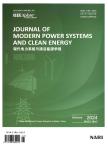Power-balancing Coordinated Control of Wind Power and Demand-side Response Under Post-fault Condition
Power-balancing Coordinated Control of Wind Power and Demand-side Response Under Post-fault Condition作者机构:China Electric Power Research InstituteBeijing 100192China North China Electric Power UniversityBeijing 102206China State Key Laboratory of Operation and Control of Renewable Energy&Storage Systems(China Electric Power Research Institute)Beijing 100192China China Institute of Energy and Transportation Integrated DevelopmentNorth China Electric Power UniversityBeijing 102206China
出 版 物:《Journal of Modern Power Systems and Clean Energy》 (现代电力系统与清洁能源学报(英文))
年 卷 期:2022年第10卷第5期
页 面:1207-1215页
核心收录:
学科分类:08[工学] 0807[工学-动力工程及工程热物理]
基 金:supported in part by the National Natural Science Foundation of China (No. 52007174)
主 题:Power-balancing wind power demand-side response frequency stability post-fault condition
摘 要:As the global energy transforms to renewablebased power system, the wind power generation has experienced a rapid increase. Due to the loss of synchronous machines and its frequency control mechanisms, the gradual evolution leads to critical challenges in maintaining the frequency stability. Under post-fault condition, the wind power generation has a slow recovery due to the fault ride-through(FRT) control strategy and may cause a larger frequency deviation due to the power imbalance between the supply and demand. Then, the impacts of the frequency deviations would further cause inaccuracy and instability in the control system for wind power generation. Considering the long parking time of electric vehicles(EVs), the demand-side response is provided to support the power grid via load-to-grid technology. Thus, a power-balancing coordinated control strategy of the wind power and the demand-side response is developed. It can significantly mitigate the power imbalance, thereby resulting in the enhanced frequency stability. Finally, the simulation results are provided to validate the power-balancing coordinated control strategy.



